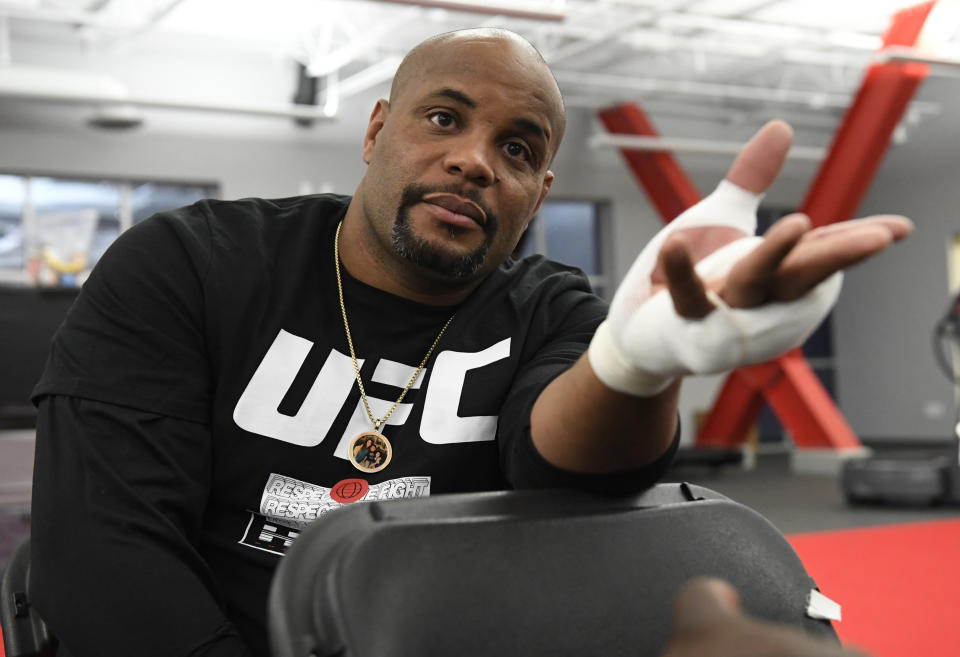How the Oura Ring helped Daniel Cormier learn he had COVID-19 and still make his fight at UFC 252
Daniel Cormier was six weeks from the final bout of his legendary career when he learned that a teammate tested positive for COVID-19.
He, along with everyone else who trained at the American Kickboxing Academy in San Jose, California, quickly got tested because of their exposure. All of them were negative, which means they didn’t have the virus.
But a few days later, Cormier started to feel poorly. He’d trained three times that day and attributed his sluggishness to fatigue. It was, though, more than that. He had COVID-19.
Cormier, though, may not have made it to his heavyweight title fight against Stipe Miocic that headlined UFC 252 on Aug. 15 in Las Vegas were it not for a piece of jewelry that helped him monitor his health.
On Tuesday, the UFC will announce a partnership with Oura Health, the company that makes the Oura Ring. The smart ring tracks health data and can warn of problems and suggest when it’s a good day to train a bit harder and when it might be wise to back off.
The UFC plans to give a ring to all of its fighters who want want one. So far, all 65 fighters that have been offered the rings, which retail for $299, have accepted.

It provides information that the trainers at the UFC Performance Institute can use to help improve the athletes’ training and, ultimately, their performance.
“We’re excited that this continues our ability at the Performance Institute to have conversations with and influence with the fighters,” UFC vice president Duncan French told Yahoo Sports. “We have expertise here at the Performance Institute that can help disseminate that information and interpret it and then strategically work with the athletes to say, ‘You know, looking at this data, maybe you need to drop a sparring round. Instead of sparring three rounds, let’s do two.’ It’s not about pulling athletes from doing the work or doing their training. It’s about being more strategic in managing it.”
The ring measures a long list of items, but one of the primary ones is quality of sleep. It provides in-depth sleep data such as automatic sleep tracking for sleep stages (awake, light sleep, deep sleep and REM sleep). It times the duration and quality of sleep and detects restless motion.
Also during sleep, the ring will track resting heart hate, heart-rate variability, respiratory rate and body temperature deviation.
During awake times, it will track activity levels, including intensity, timing and duration. It will count calories and steps, detect inactive times and detect restful moments during the day.
Cormier: ‘This is not an excuse at all’
Cormier began using the ring because a fitness trainer he hired for the Miocic fight recommended it. He raved about it repeatedly during a brief conversation with Yahoo Sports.
“I think it’s a fantastic product, man,” Cormier said. “The reason I told anyone that I would be involved with it in any way, shape or form is because I believe in it so much. I think everyone should be wearing one. It’s that good.”
One of the things that the ring does is provide a readiness score, which helps an athlete know how best to train on a given day. It was the change in his readiness score, along with some other data, that suggested Cormier should see a doctor.
The ordeal began on July 1 when Cormier’s teammate tested positive for COVID-19. Cormier, his coaches and teammates were negative when results were returned July 3.
“But over the weekend, I started feeling a little sick,” Cormier said. “Things weren’t exactly ... well, let me put it this way: I wasn’t sick, but I got a little tired and peaked. Monday comes, I go to practice and I spar and I worked out three times. I felt OK, but I was a little bit tired is, I guess, how I would put it. Now, let me go back for a second: The Wednesday prior, my readiness score was at 78, 79. The readiness score is what tells you how you are supposed to approach the day. When it’s low, it’s telling you to take a step back.
“I’ve been using it for months now because my body needs to know if I’m going in the right direction. … On Monday night, Tuesday morning, I wasn’t feeling so good. My resting heart rate had been 50 beats a minute. Now it was at 57. My body temperature had changed.”
He went to practice on Tuesday anyway, and didn’t feel good. He was thinking of stopping and his coaches mocked him. But when he awakened on July 8, his readiness score had dropped to 48. And his resting heart rate went up to 67.
He went to practice that day and sparred two rounds, but told coach Javier Mendez he wasn’t feeling good. He went to the doctor and discovered he had COVID-19.
The coaches, who had mocked him and asked him if Marvin Hagler and Muhammad Ali wore a ring, were amazed.
“The ring didn’t tell me I had COVID,” Cormier said. “But the ring told me that something wasn’t right, and I used the information to make a decision to go see the doctor. I found out then that I had COVID, but the information I got from the ring allowed me to make the fight.
“This is not an excuse at all. Miocic won the fight and he fought beautifully. This is a thank you almost to Oura for allowing me to get to the fight. I might have just kept pushing and not known I had it. But I was able to take care of myself properly and then get back into training and compete for the heavyweight championship of the world. Without the ring, I don’t think that’s possible.”

More NFL from Yahoo Sports:

 Yahoo Home
Yahoo Home 
